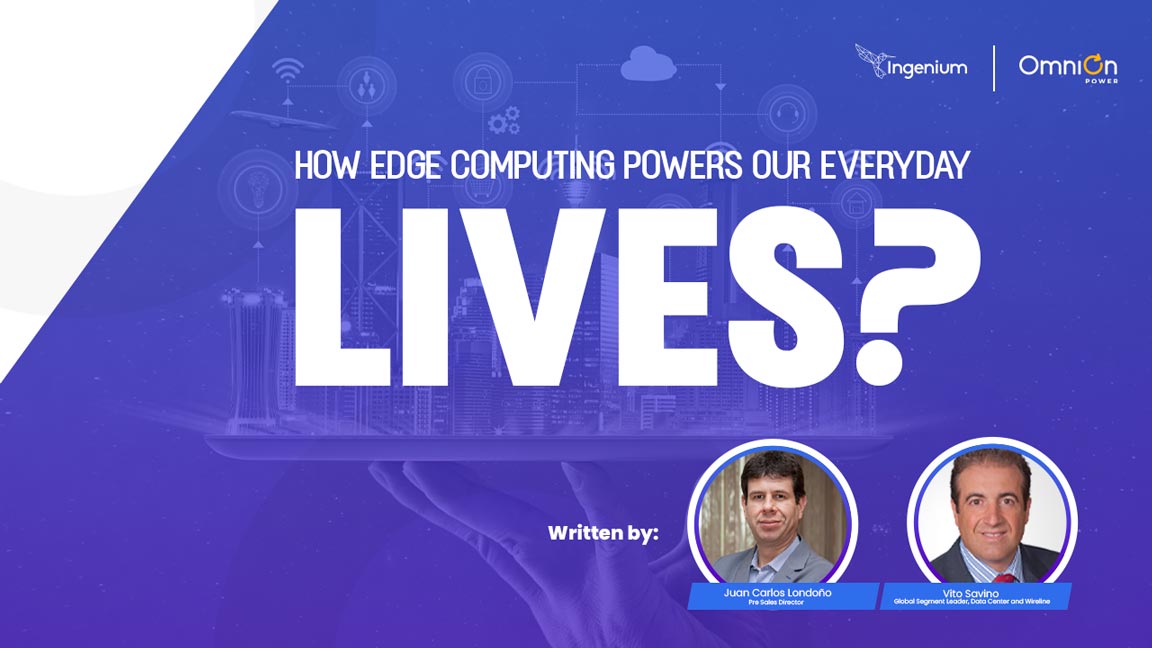By Vito Savino, Global Segment Leader, Data Center and Wireline, OmniOn Power
Power Considerations for Consumer Edge Computing Use Cases
Edge computing has been leveraged for years as technologies that require powerful, low-latency computing, like machine learning and the Internet of Things, have made their way into regular business operations. Popular business use cases include autonomous warehouses and several applications within the healthcare and military sectors, such as remote diagnostics and surgeries, military scouting, and the remote control of airborne weapons. And now with the rapid emergence of artificial intelligence (AI), the need for edge computing technology has grown exponentially.
On the consumer front, edge computing is on track to emerge as an aid to many everyday applications, including smart electrical grids, fleet management, public safety, emergency response, and more. The possibilities are exciting, but there are challenges that could slow widespread adoption – including powering the edge data centers supporting these applications. Let’s dig into the details.
Drivers for the Mainstream Adoption of Edge Computing
For consumer applications, one challenge is bringing edge computing and data centers closer to the people who rely on them. With the power of AI-driven applications like ChatGPT at our fingertips, e-commerce a critical aspect of everyday lives, real-time financial transactions ingrained in our lives, the popularity of massive multiplayer gaming, and interactive entertainment leveraging augmented reality (AR), the need for edge data centers has never been more significant.
These applications all require low-latency data processing. AR in interactive social media experiences, where the real world meets computer-generated sounds and visual elements, will require extensive computing as well as infrastructure like radio transmitters, towers, and backup battery power to make it all reliable.
Sporting events, for example, are starting to offer new experiences for fans by leveraging AR to provide real-time stats, line-ups, heatmaps, and insights right through and in an augmented reality overlay on their phones. The ability to deliver AR content like this accurately and in real time hinges on low latency, reliable data processing close to the source and the user.
Many consumers run their lives from their phones and depend on quick, seamless data processing – which, in turn, requires more widely deployed edge data centers.
Barriers to Mainstream Use and What Needs to Change
There are several barriers to the mainstream adoption of edge computing, including those that revolve around public support, safety, and efficiency.
To appropriately support growing consumer need and help facilitate the influx of data-intensive applications, more edge data centers will need to be installed closer to point-of-need, such as in neighborhoods, housing complexes, offices, and entertainment venues. And putting data centers in these areas could be a hard sell for providers and consumers alike.
In addition, edge computing requires a lot of power and can create a lot of heat. This heat must be dissipated to avoid damaging equipment and sacrificing operations. Data center designs in small huts and buildings will need to leverage highly efficient power designs that can accurately and efficiently control voltage output in smaller spaces.
Depending on where edge data centers are deployed, the quality and reliability of utility power may present challenges, with surges or varying voltages potentially impacting data center operations. To mitigate this, power needs to be efficiently processed and converted from the grid to the end use, and reliable and redundant backup power is essential.
A power outage in an edge data center could have significant end-user implications. For example, someone conducting a sensitive bank transaction could suddenly and irreversibly lose crucial financial data—and the money that goes with it.
The slower-than-anticipated rollout of 5G networks, which will increasingly rely on edge data centers, has also proved a barrier to mainstream edge computing use. These networks – and the applications they enable – will drive the need for increased edge data centers.
Where Do We Go From Here?
Edge computing has a real opportunity to make a difference in the lives of everyday consumers — not just in niche industries with complex equipment. But to get there, we’ll need significant buy-in and teamwork between government entities, service providers, and companies to build out the infrastructure needed.
The expert's eye - INGENIUM
We agree with Vito that there are various drivers of Edge Computing, even more so today with the great leverage that generative AI provides through the development of current and future services and applications that are increasingly more diverse and expanding into new markets and Industries that we did not see so clearly before, such as the food and beverage market, just to mention one example.
There are other factors that may hinder the speed of implementation of Edge Computing, in addition to the reliability of the energy and the slowness of the deployment of 5G – these two aspects are especially being presented in the LATAM region -, such as being able to have the appropriate multiple spaces to not only implement Edge Computing solutions but also the communication antennas of the 5G networks themselves; physical security to protect those solutions in such spaces; the increasing risks due to the increase in cybercrime; and even the higher capital costs for the implementation of new physical infrastructure projects, among others.
However, the following is clear: the growth in data generation, transmission and analysis driven for several years by IOT devices, Big Data, M2M, and more recently by Machine-Learning and Generative AI, undoubtedly points to the fact that Edge Computing will not only grow, but must continue to grow at a very good pace to avoid slowing down the increase in data and its enormous implication in different markets and industries.
About the Authors:
Vito Savino is the global data center and wireline segment leader for OmniOn Power, where he works with data center and telecommunications customers to provide advanced solutions for their dynamic power challenges.
Learn more about OmniOn Power and how it can help solve your unique power challenges by visiting https://www.omnionpower.com/
Juan Carlos Londoño is Presales Director at Ingenium, which is one of the leading firms in consulting, engineering, construction and operation of data centers, mission-critical infrastructure and facilities in Latin America. Ingenium is known for their experience and partner relationships to deliver speed to market for operators to make them more competitive. Learn more about Ingenium.



